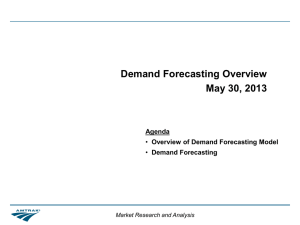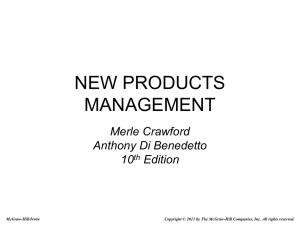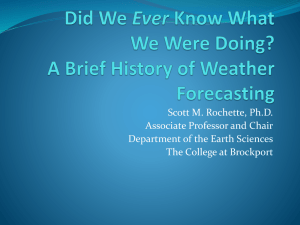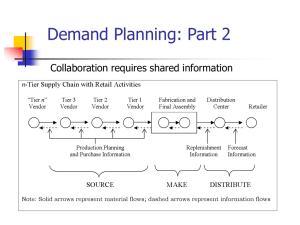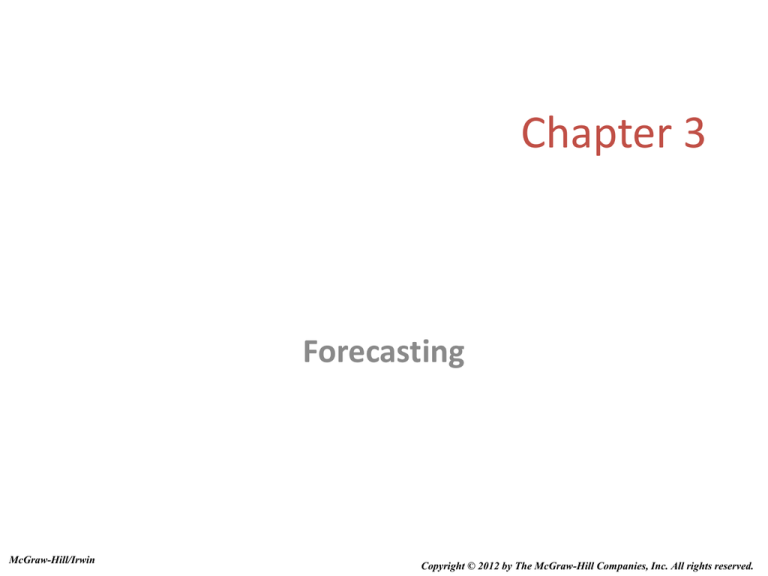
Chapter 3
Forecasting
McGraw-Hill/Irwin
Copyright © 2012 by The McGraw-Hill Companies, Inc. All rights reserved.
Chapter 3: Learning Objectives
You should be able to:
List the elements of a good forecast
Outline the steps in the forecasting process
Describe qualitative forecasting techniques and the
advantages and disadvantages of each
Compare and contrast qualitative and quantitative
approaches to forecasting
Describe averaging techniques, trend and seasonal
techniques, and regression analysis, and solve typical
problems
Explain three measures of forecast accuracy
Compare two ways of evaluating and controlling forecasts
Assess the major factors and trade-offs to consider when
choosing a forecasting technique
3-2
Forecast
Forecast – a statement about the future
value of a variable of interest
We make forecasts about such things as weather,
demand, and resource availability
Forecasts are an important element in making
informed decisions
3-3
Two Important Aspects of
Forecasts
Expected level of demand
The level of demand may be a function of some
structural variation such as trend or seasonal
variation
Accuracy
Related to the potential size of forecast error
3-4
Features Common to All Forecasts
Techniques assume some underlying causal
system that existed in the past will persist
into the future
Forecasts are not perfect
Forecasts for groups of items are more
accurate than those for individual items
Forecast accuracy decreases as the
forecasting horizon increases
3-5
Elements of a Good Forecast
The forecast
should be timely
should be accurate
should be reliable
should be expressed in meaningful units
should be in writing
technique should be simple to understand and
use
should be cost effective
3-6
Steps in the Forecasting Process
Determine the purpose of the forecast
Establish a time horizon
Obtain, clean, and analyze appropriate data
Select a forecasting technique
Make the forecast
Monitor the forecast
3-7
Forecast Accuracy and Control
Forecasters want to minimize forecast errors
It is nearly impossible to correctly forecast real-world
variable values on a regular basis
So, it is important to provide an indication of the
extent to which the forecast might deviate from the
value of the variable that actually occurs
Forecast accuracy should be an important
forecasting technique selection criterion
Error = Actual – Forecast
If errors fall beyond acceptable bounds, corrective
action may be necessary
3-8
Forecast Accuracy Metrics
Let et = Actualt – Forecastt, where t = given time period
e
MAD
t
MAD weights all errors evenly
n
e
MSE
2
t
n 1
et
Actual 100
t
MAP E
n
MSE weights errors according
to their squared values
MAPE weights errors
according to relative error
3-9
Forecast Error Calculation
Period
Actual
(A)
Forecast
(F)
(A-F)
Error
|Error|
Error2
[|Error|/Actual]x100
1
107
110
-3
3
9
2.80%
2
125
121
4
4
16
3.20%
3
115
112
3
3
9
2.61%
4
118
120
-2
2
4
1.69%
5
108
109
1
1
1
0.93%
Sum
13
39
11.23%
n=5
n-1 = 4
n=5
MAD
MSE
MAPE
= 2.6
= 9.75
= 2.25%
3-10
Forecasting Approaches
Qualitative Forecasting
Qualitative techniques permit the inclusion of
soft information such as:
o Human factors
o Personal opinions
o Hunches
These factors are difficult, or impossible, to
quantify
3-11
Forecasting Approaches
Quantitative Forecasting
Quantitative techniques involve either the
projection of historical data or the development
of associative methods that attempt to use causal
variables to make a forecast
These techniques rely on hard data
3-12
Qualitative Forecasts
Executive opinion
Sales force opinion
Consumer Survey
Delphi method
3-13
Executive Opinion
Involves small group of high-level experts and
managers
Group estimates demand by working together
Combines managerial experience with statistical
models
Relatively quick
‘Group-think’ is a disadvantage
3-14
Sales Force Opinion
Each salesperson projects his or her sales
Combined at district and national levels
Sales reps know customers’ wants
Tends to be overly optimistic
3-15
Delphi Method
Participants include
Decision makers
Staff
Outside experts
Anonymous iterative group process,
continues until consensus is reached
3-16
Consumer Survey
Ask customers about purchasing plans
Time consuming and expensive
May require complex statistical analysis
What consumers say, and what they actually
do are often different
3-17
Quantitative Forecasts
Time series methods
Associative forecasting techniques
3-18
Time-Series Forecasts
Forecasts that project patterns identified in
recent time-series observations
Time-series - a time-ordered sequence of
observations taken at regular time intervals
Assume that future values of the time-series
can be estimated from past values of the
time-series
3-19
Time-Series Behaviors
Trend
Gradual increase or decrease over long period of
time
Seasonality
Regular and repeating changes
Cycles
Ups and downs due to economic cycles
3-20
Time-Series Behaviors
Irregular variations
Unexpected changes
Random variation
3-21
Time-Series Behaviors
3-22
What model when
Seasonality not present
Trend not present
•
•
•
•
Trend is present
• Naive
• Trend projection using
Regression
Naive
Moving Average
Weighted Moving Average
Exponential smoothing
Seasonality is present
• Naive
• Seasonal index
• Seasonal index
• With trend projection
No trend and no seasonality
Naïve Forecast
Uses a single previous value of a time series as
the basis for a forecast
o The forecast for a time period is equal to the previous
time period’s value
Ft+1 = At
3-24
Averaging forecasts
These Techniques work best when a series
tends to vary about an average
Averaging techniques smooth variations in the
data
They can handle step changes or gradual changes
in the level of a series
Techniques
o Moving average
o Weighted moving average
o Exponential smoothing
3-25
Moving Average
Technique that averages a number of the
most recent actual values in generating a
n
forecast
Ft 1 MAn
A
i 1
t i 1
n
where
Ft Forecastfor timeperiodt
MAn n periodmovingaverage
At Actual value in periodt
n Number of periodsin themovingaverage
3-26
Moving Average
As new data become available, the forecast is
updated by adding the newest value and
dropping the oldest and then re-computing
the average
The number of data points included in the
average determines the model’s sensitivity
Fewer data points used-- more responsive
More data points used-- less responsive
3-27
Weighted Moving Average
The most recent values in a time series are
given more weight in computing a forecast
The choice of weights, w, is somewhat arbitrary
and involves some trial and error
Ft 1 wt ( At ) wt 1 ( At 1 ) ... wt n ( At n )
where
wt weight for periodt , wt 1 weight for periodt 1, et c.
At t heact ual value for periodt , At 1 t heact ual value for periodt 1, et c.
and Sum of weight s 1
3-28
Exponential Smoothing
A weighted averaging method that is based
on the previous forecast plus a percentage of
the forecast error
Ft 1 At (1 ) Ft
Ft 1 Ft ( At Ft ) Ft ( et )
where
Ft 1 Forecast for periodt 1
Ft Forecast for theperiodt
= Smoothingconstant
At Actual demand or sales for period just ended
3-29
Techniques for Trend
Linear trend equation
Non-linear trends
3-30
Linear Trend
A simple data plot can reveal the existence
and nature of a trend
Naïve forecast with trend
Ft+1 = At + (At – At-1)
3-31
Linear Trend - Regression
Linear trend equation
Ft a bt
where
Ft Forecastfor periodt
a Value of Ft at t 0
b Slope of theline
t Specified number of timeperiodsfromt 1
3-32
Estimating slope and intercept
Slope and intercept can be estimated from
historical data
b
n ty t y
n t
2
t
y b t
a
n
2
or y bt
where
n Number of periods
y Value of the time series
3-33
Techniques for Seasonality
Seasonality – regularly repeating movements
in series values that can be tied to recurring
events
Expressed in terms of the amount that actual
values deviate from the average value of a series
Naïve forecast
Ft+1 = At-s+1
where s = No. of periods
3-34
Techniques for Seasonality
Models of seasonality
Additive
o Seasonality is expressed as a quantity that gets added
to or subtracted from the time-series average in order
to incorporate seasonality
Multiplicative
o Seasonality is expressed as a percentage of the
average (or trend) amount which is then used to
multiply the value of a series in order to incorporate
seasonality
3-35
Models of Seasonality
3-36
Seasonal Relatives
Seasonal relatives
The seasonal percentage used in the multiplicative
seasonally adjusted forecasting model
Deseasonalizing data
o Done in order to get a clearer picture of the nonseasonal
(e.g., trend) components of the data series
o Divide each data point by its seasonal relative
Incorporating seasonality in a forecast
o Obtain trend estimates for desired periods using a trend
equation
o Add seasonality by multiplying these trend estimates by the
corresponding seasonal relative
Associative Forecasting Techniques
Associative techniques are based on the
development of an equation that summarizes
the effects of predictor variables
Predictor variables - variables that can be used to
predict values of the variable of interest
o Home values may be related to such factors as home
and property size, location, number of bedrooms, and
number of bathrooms
3-38
Simple Linear Regression
Regression - a technique for fitting a line to a
set of data points
Simple linear regression - the simplest form of
regression that involves a linear relationship
between two variables
o The object of simple linear regression is to obtain an
equation of a straight line that minimizes the sum of
squared vertical deviations from the line (i.e., the least
squares criterion)
3-39
Least Squares Line
yc a bx
where
yc P redicted(dependent) variable
x P redictor(independent) variable
b Slope of theline
a Value of yc when x 0 (i.e., theheight of theline at they intercept)
and
b
n xy x y
n x x
2
2
y b x
a
or y b x
n
where
n Number of pairedobservations
3-40
Monitoring the Forecast
Tracking and analyzing forecast errors
provides insight into whether forecasts are
performing satisfactorily
Sources of forecast errors
The model may be inadequate
Irregular variations may have occurred
The forecasting technique has been incorrectly
applied
Random variation
3-41
Choosing a Forecasting Technique
Factors to consider
Cost
Accuracy
Availability of historical data
Availability of forecasting software
Time needed to gather and analyze data and
prepare a forecast
Forecast horizon
3-42


